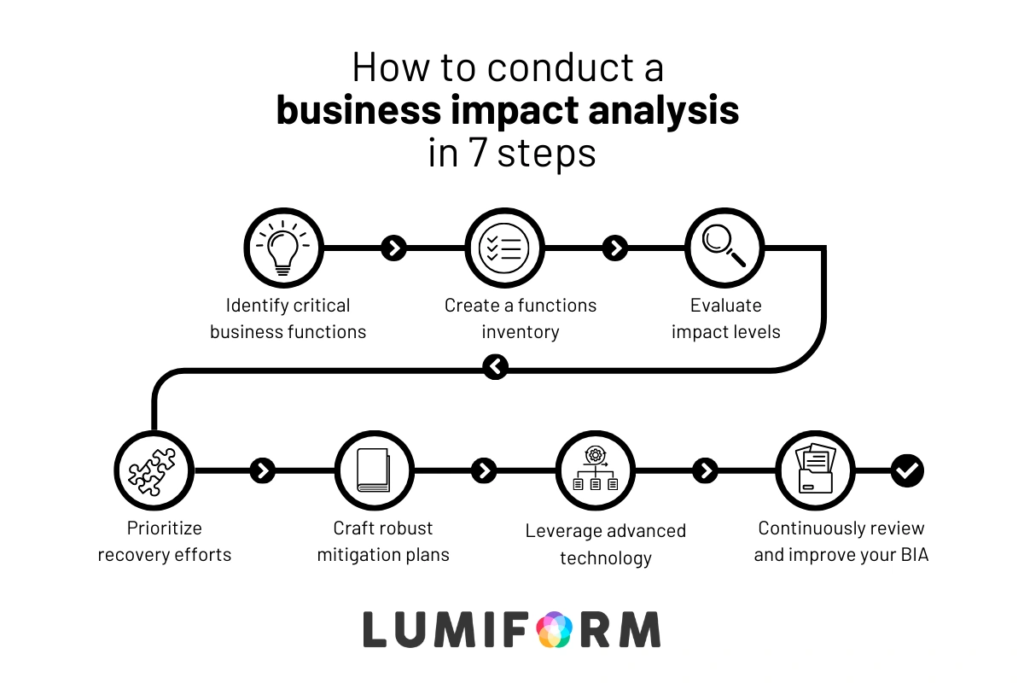Are you looking to strengthen your organization’s resilience against unexpected disruptions? This guide on business impact analysis (BIA) is tailored for you. Whether you’re aiming to mitigate cyber risks like leading financial institutions or streamline your supply chain like top manufacturers, BIA is your key to understanding and managing operational impacts.
Here, you’ll find actionable strategies, successful examples, and expert insights to help you implement an effective BIA. By leveraging these tools, you can foster a culture of preparedness, ensuring your company not only survives but thrives in the face of challenges.
Discover how to bolster your corporate resilience and secure your organization’s future success.
Learning from real-world case studies
Examining real-world case studies provides valuable insights into effective BIA practices.
Case study 1 – The cyberattack on a central bank
A financial institution successfully mitigated the impacts of a cyberattack by implementing a robust Business Continuity Plan (BCP) and Disaster Recovery Plan (DRP). Regular testing and updates were key to maintaining their preparedness.
For example, the International Monetary Fund (IMF) highlights how a major cyberattack on the central bank of Bangladesh in 2016 exploited vulnerabilities in the SWIFT system, leading to the theft of $101 million.
The incident underscored the importance of robust cybersecurity measures and continuous improvement in response strategies.
Case study 2: How manufacturers reduce risk of product recalls
A manufacturing company significantly improved its operational efficiency and resilience by leveraging manufacturing analytics. According to IT Convergence, a car parts manufacturer used manufacturing analytics to analyze data from sensors and other sources to detect anomalies in the production process.
They also used predictive analytics to forecast potential issues and take corrective action before defects occurred. This approach helped the manufacturer reduce the risk of product recalls, improve customer satisfaction, and ensure continuity during disruptions.
Key takeaways from real-world case studies
Thoughtful insights and actionable advice for a resilient Business Impact Analysis (BIA):
- Regular Testing: Continuously test and update your Business Continuity and Disaster Recovery Plans to keep them effective.
- Security Measures: Implement industry-specific security protocols and conduct regular audits and training.
- Advanced Analytics: Use analytics to monitor data and predict issues, enhancing operational efficiency.
- Stakeholder Engagement: Involve key stakeholders regularly to ensure alignment with evolving needs.
- Critical Functions: Prioritize essential functions to minimize disruption impacts.
- Continuous Improvement: Keep your BIA updated to reflect changes and maintain effectiveness.
Adapt these insights to build a robust BIA that ensures smooth operations during disruptions.
7 steps to conducting a solid business impact analysis
Business Impact Analysis (BIA) is a crucial process that systematically identifies and evaluates the potential impacts of disruptions on business operations. Conducting an analysis ensures your organization can withstand and recover from disruptions.
This process involves seven key steps: identifying critical business functions, creating a function inventory, evaluating impact levels, prioritizing recovery efforts, crafting robust mitigation plans, and leveraging advanced technology.
Step 1: Identify critical business functions
Identifying critical business functions is the first step in a BIA. These functions are essential for the survival and success of your organization. Core activities are essential processes that directly impact your organization’s ability to deliver products or services.
Support services include activities that support core operations, such as IT, HR, and finance. Recognizing these functions helps in prioritizing efforts during disruptions.
Understanding which functions are truly critical allows you to focus your resources where they matter most, ensuring your organization remains resilient.
Step 2: Create a functions inventory
Once you have identified the critical business functions, the next step is to develop a comprehensive inventory of all business functions within your organization. This involves:
- Mapping processes: Document workflows and processes to understand their interdependencies.
- Identifying resources: Determine the resources required for each function, including personnel, technology, and physical assets.
Creating a detailed inventory provides a clear picture of how your organization operates and what is needed to maintain its functionality. This foundational step sets the stage for effective impact analysis.
Step 3: Evaluate impact levels
With a clear inventory in hand, the next step is to assess the potential impact of disruptions. This involves determining the severity and likelihood of various disruption scenarios. Key steps include identifying disruption scenarios by considering a range of potential disruptions, from minor incidents to major crises.
Measure impact levels by evaluating the financial, operational, and reputational impacts of each scenario. This risk assessment helps in understanding the potential consequences and preparing accordingly.
Evaluating these impacts ensures preparedness for any eventuality, minimizing potential damage to your organization.
Step 4: Prioritize recovery efforts
Following the evaluation of impact levels, it is crucial to prioritize recovery efforts based on the urgency of each business function. Consider the following:
- Maximum tolerable downtime (MTD): Assess the longest period a function can be unavailable without causing significant harm.
- Recovery time objectives (RTO): Establish the target time frame for restoring a function after a disruption.
Prioritizing recovery efforts ensures that the most critical functions are restored first, minimizing overall disruption. This approach helps maintain business continuity during challenging times.
Step 5: Craft robust mitigation plans
After prioritizing recovery efforts, the next step is to implement mitigation strategies to minimize the impacts of disruptions. Effective strategies include developing comprehensive business continuity plans (BCP) that outline procedures for maintaining operations during disruptions.
Additionally, create disaster recovery plans (DRP) that focus on restoring IT systems and data after a disruption. These plans ensure that your organization can quickly recover and resume critical functions.
Crafting robust mitigation plans provides a safety net, ensuring your organization can withstand and recover from disruptions efficiently.
Step 6: Leverage advanced technology
To further enhance your mitigation efforts, leveraging advanced technology is essential. This includes:
- Backup solutions: Implement regular data backups and off-site storage to safeguard information.
- Redundancy measures: Establish redundant systems and processes to ensure continuity during disruptions.
Leveraging advanced technology safeguards your data and ensures that your operations can continue seamlessly, even in the face of disruptions. This technological edge is crucial for maintaining business operations under adverse conditions.
Step 7: Continuously review and improve your BIA
To ensure the BIA remains relevant and effective, it is essential to continuously review and improve the analysis. This involves regularly updating the BIA to reflect changes and change management practices in business operations, technology, and external threats. Conduct periodic reviews and simulations to test the effectiveness of your plans and identify areas for improvement.
Engage stakeholders in the review process to gather insights and ensure that the BIA aligns with current business needs and industry best practices. Continuously improving the BIA ensures that your organization is always prepared for potential disruptions and can respond effectively.
Following these steps enables you to effectively conduct a business impact analysis and develop strategies to protect your organization from potential disruptions. Each step builds on the previous one, creating a cohesive and comprehensive approach to business continuity planning. This structured methodology ensures that your organization is well-prepared to handle any disruptions and continue operating smoothly.
Foster a culture of preparedness
Creating a culture of preparedness is essential for effective business continuity. Every team member should understand the importance of business continuity and their role in maintaining it. Open communication and recognition programs are key components.
Regularly discuss potential risks and acknowledge employees who contribute to your organization’s business continuity framework. Promote open dialogue about risks and proactive planning to identify vulnerabilities early.
Recognize and reward employees who demonstrate exceptional commitment to business continuity. Conduct regular training sessions using real-life scenarios to make the training engaging and effective.
Leveraging expert recommendations
Leverage expert insights to enhance your BIA strategy. Industry experts provide valuable recommendations to optimize your approach to business continuity. Adopting a holistic approach and staying ahead of regulations are critical aspects of a robust BIA strategy. Experts also emphasize utilizing advanced analytics to predict potential disruptions and improve operational efficiency.
Gain professional insights
- Utilize advanced analytics: Implement data analytics to identify trends and predict potential disruptions.
- Stay ahead of regulations: Keep informed about regulatory changes and ensure your BIAs comply with the latest standards.
- Adopt a holistic approach: Consider all aspects of your business, including supply chain, IT infrastructure, and human resources.
- Engage stakeholders: Actively involve key stakeholders in the BIA process to align with evolving needs and threats.
- Leverage industry best practices: Stay updated on best practices by participating in professional networks and conferences.
Following these expert recommendations will help develop a more robust and resilient BIA strategy.
Stay current with industry trends
Regularly updating your knowledge of industry best practices and emerging technologies is crucial for maintaining an effective BIA. Engage with industry peers and experts through conferences, webinars, and online forums for valuable insights.
Continuous learning and improvement are essential; encourage your team to pursue professional certifications like Certified Business Continuity Professional (CBCP) or Certified Information Systems Security Professional (CISSP). Participate in professional networks and join industry organizations to stay current with the latest developments and regulatory changes.
Networking provides new perspectives and innovative solutions, ensuring your organization remains resilient and prepared for disruptions.
Equip your team with essential tools
Providing your team with the right tools and resources is vital for conducting effective BIAs. This includes comprehensive templates, continuous education, and access to online resources. Equipping your team ensures they have the necessary support to perform thorough and accurate assessments.
Provide essential tools
- BIA templates: Employ free and powerful Business Impact Analysis tools to standardize and streamline the assessment process.
- Training programs: Offer continuous education and training on best practices and regulatory requirements.
- Access online resources: Use digital platforms for continuous learning and updates on best practices.
- Collaboration tools: Equip your team with project management software and communication platforms.
- Scenario planning tools: Provide tools for conducting scenario planning exercises.
Equipping your team with these tools enhances their ability to conduct effective BIAs, improving organizational resilience.
Build resilience through continuous improvement
Integrating BIAs into your organizational culture is essential for building resilience. Regular audits and feedback mechanisms ensure continuous improvement and preparedness. Conduct frequent audits to identify improvement areas and ensure continuity standards compliance. Implement systems for employees to provide feedback on continuity practices and suggest improvements.
Regularly conduct scenario planning exercises to test your business continuity plans against various disruption scenarios. Recognizing and rewarding employees who excel in maintaining and improving BIAs motivates ongoing excellence and reinforces the importance of preparedness.
Recognize and reward excellence
Acknowledging the efforts of teams and individuals who excel in maintaining and improving BIAs is crucial for fostering a culture of continuous improvement.
Recognition programs
- Implement a rewards program: Recognize employees for their contributions to business continuity.
- Motivation and engagement: Foster a culture of resilience and preparedness by recognizing and rewarding employees.
- Public acknowledgment: Acknowledge efforts through newsletters, meetings, or social media.
- Incentives and benefits: Offer incentives like bonuses, additional paid time off, or professional development opportunities.
- Continuous improvement: Encourage employees to seek ways to improve business continuity practices.
By recognizing and rewarding employees, you foster a culture of resilience and continuous improvement, ensuring your organization remains prepared for any disruptions.
Attain BIA excellence with Lumiform
Take the challenge to enhance your organization’s resilience with Business Impact Analysis. This week, dive into Lumiform’s platform to explore and implement your BIA. Leverage our robust template creation tools, extensive libraries, and automation features to streamline your process.
Empower your team with comprehensive audits to elevate standards and address areas needing improvement and compliance.
Click here to get started.

